Engaging Kindergarten Physical Education Games


Intro
Physical education in kindergarten is crucial for the development of young children. Engaging in physical activities not only helps in building motor skills but also fosters teamwork, social interaction, and emotional resilience. In this article, we will explore a variety of physical education games tailored specifically for kindergarteners. We will look into their benefits, how to implement them effectively, and ways to create an inviting environment for young learners.
Creative Activities
Creative activities are an essential component of physical education. They allow children to express themselves while also being active. Below are some ideas for creative physical education games that can be easily adapted for kindergarteners.
Craft Ideas
- Obstacle Course Creation: Encourage children to use different materials—cones, hoops, or soft blocks—to craft their own obstacle courses. This improves spatial awareness and physical agility.
- Movement Art: Have children paint or draw their favorite activities. They can then act out their drawings, combining art with movement.
Step-by-Step Guides
- Setting Up an Obstacle Course:
- Movement Art Activity:
- Gather materials like cones or ropes.
- Define a clear start and end point.
- Guide children on how to navigate through the course, demonstrating movements.
- Provide paper and colors.
- Ask children to create illustrations of activities they enjoy.
- Allow them to demonstrate the activities to their peers after completing the drawings.
Educational Value
Engaging in such creative activities enhances cognitive functions. It allows children to engage in problem-solving while developing fine motor skills through crafts. Additionally, they learn about teamwork and communication as they work together and share their ideas.
Fun Quizzes
Fun quizzes can also serve as a useful tool in reinforcing what children learn through physical games. Incorporating quizzes makes the overall experience more interactive.
Quiz Topics
- Sports Recognition: Identify various sports games and their rules.
- Movement Vocabulary: Understanding terms related to movement and body actions.
Question Types
- Multiple Choice: Simple options for young children to choose the correct answer.
- True or False: Engaging statements that children can affirm or deny.
Knowledge Reinforcement
Quizzes reinforce learning in a playful manner, enhancing memory retention. By connecting physical activities with quizzes, children can better recall skills they have practiced during games, creating an integrated learning experience.
Fact-Based Articles
Fact-based articles can be an enriching addition to physical education. They provide information in an engaging format.
Topics
- Health Benefits of Physical Activity: Understanding how movement contributes to overall health.
- Sports History: Basic facts about various sports and their origins.
Engaging Content
These articles use simple language and relatable examples to make learning enjoyable. Illustrations can make the content more visually appealing to kindergarteners.
Intro to Kindergarten Physical Education
Physical education in kindergarten forms a foundational stone in a child's comprehensive development. This topic holds significance as it encapsulates the activities and structured games that can positively influence various dimensions of a child's growth, including physical, social, emotional, and cognitive areas. By focusing on early childhood physical education, we emphasize the crucial role that movement and play have in fostering not only health but also vital skills.
Engaging in physical activities helps in developing gross and fine motor skills, which are essential for daily tasks. Additionally, introducing organized games at a young age can cultivate teamwork and enhance social interactions among peers. Effective physical education also encourages children to be active participants in their learning journey, creating deeper connections with the educational material presented.
Given the many benefits, it becomes clear that incorporating physical education in kindergartens is not merely a bonus but a necessity. This ultimately leads to the cultivation of a physically literate generation, able to appreciate and participate in lifelong fitness. Educators and caregivers must recognize how structured games can serve as tools to guide children toward healthy habits and critical skills development while contributing to their overall education.
Defining Physical Education in Early Childhood
Physical education in early childhood focuses on structured physical activity that enhances children's physical competencies. It emphasizes the importance of developing a range of movements, from running and jumping to throwing and catching. Effective early childhood programs also encompass the teaching of basic rules and fair play, laying a pathway for social awareness and cooperation.
Physical education does not just entail exercise; it also integrates play as a means to teach and reinforce skills. Children engage in activities that support their holistic development while experiencing joy and satisfaction through movement. This multifaceted approach helps establish a positive attitude toward physical activity from a young age.
The Role of Play in Learning
Play serves as a cornerstone for effective learning in early childhood education. Through play, children explore their environment, develop creativity, and practice problem-solving skills. Physical games and activities offer unique opportunities for learning that extend beyond traditional academic settings.
Engagement in play-based learning initiates a natural curiosity, allowing children to experiment, discover, and understand various concepts, particularly in social interactions. They learn the value of teamwork when collaborating in games, as well as how to resolve conflicts when disagreements arise.
"Play is the highest form of research." - Albert Einstein
By prioritizing play in the learning process, educators can enhance children's cognitive development. Each game can be designed to promote specific learning objectives while keeping children interested and engaged. Ultimately, the integration of play into physical education transforms it into a versatile tool for academic and personal growth.
Developmental Benefits of Physical Education
Physical education plays a crucial role in the growth and development of kindergarteners. Engaging in structured physical activities helps support not merely physical health but also emotional, social, and cognitive growth. Such holistic development is vital at this young age due to the rapid changes and challenges children encounter. The foundational skills acquired during physical education will foster healthy habits and promote lifelong engagement in activities.
Physical Development: Building Motor Skills
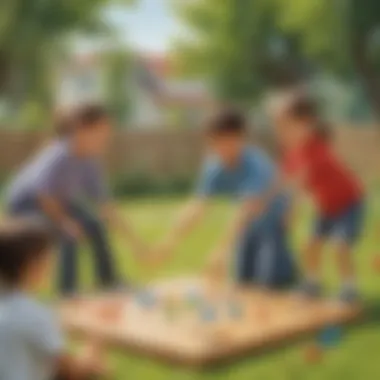
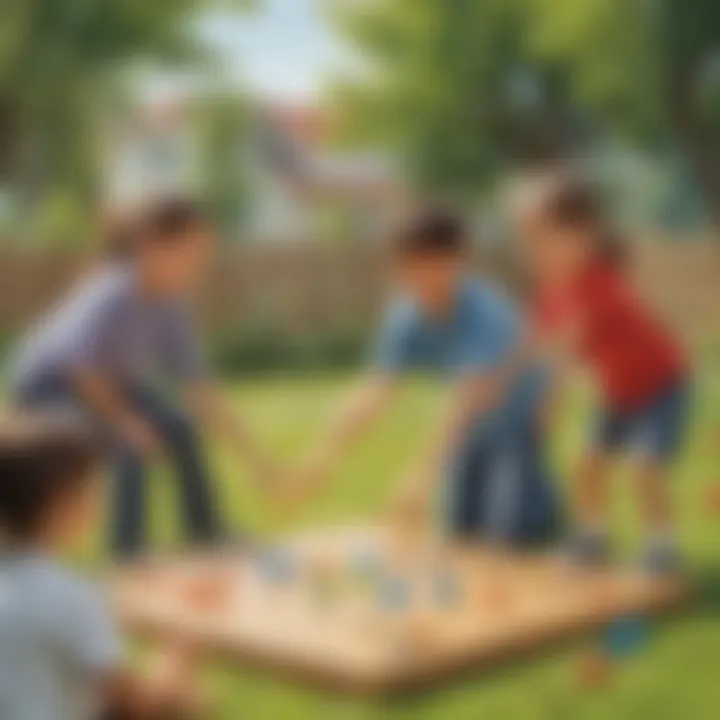
Gross Motor Skills
Gross motor skills are essential for children's physical development. They involve movements that engage large muscle groups, such as running, jumping, and throwing. These skills allow children to navigate their environment effectively.
A key characteristic of gross motor skills is their importance in forming coordination and balance. They support activities such as walking and climbing, which are fundamental for daily life. Games that involve these skills, like tag or obstacle courses, are popular in kindergarten physical education because they promote vigorous activity while being enjoyable.
A unique feature of gross motor skills is their ability to enhance spatial awareness. As children learn to control their bodies, they also develop a sense of how to maneuver within spaces. This training has the advantage of helping them become more confident in their physical abilities. However, excessive focus on competitive activities may lead to frustration among some children who are still developing these skills.
Fine Motor Skills
Fine motor skills involve the use of smaller muscle groups, particularly in the hands and fingers. Skills like grasping, pinching, and using tools fall under this category. In kindergarten, fine motor skills are crucial as they lay the groundwork for tasks such as writing and crafting.
The key characteristic of fine motor skills is their role in precision. Children learn to control their movements better, which contributes to their ability to engage in complex tasks. Activities like drawing or building with blocks can enhance these skills effectively.
A unique feature of fine motor skills is their significant impact on cognitive development. As children manipulate objects, they also enhance their problem-solving abilities. The advantage here is clear: fostering fine motor skills can influence academic performance positively. However, fine motor activities can require more time and patience, which some children might find challenging.
Social and Emotional Development
Teamwork
Teamwork is a vital component of social development in physical education. It teaches children to collaborate and communicate, essential skills for building relationships. Through cooperative games, children learn how to share responsibilities and celebrate collective achievements.
The key characteristic of teamwork is its ability to cultivate a sense of belonging. When working towards a common goal, children form bonds that nurture friendships. Created activities that require teamwork, such as relay races, foster excitement about cooperation.
A unique feature of teamwork is the opportunity for children to learn empathy. Understanding others' feelings helps them navigate social situations better. The advantage of this lies in its potential to decrease instances of bullying. However, challenges may arise when kids are not well-rounded in working with others, sometimes leading to conflicts.
Conflict Resolution
Conflict resolution is another important aspect of social and emotional learning. During games, disagreements may surface. Teaching children to address these conflicts constructively is crucial for their development. Effective resolution skills prepare them to handle disputes in daily life.
The key characteristic of conflict resolution is its emphasis on communication. Children learn to express their feelings and listen to others, fostering understanding. Incorporating role-playing games can be beneficial in teaching these skills.
A unique feature of conflict resolution is the necessity of perspective-taking. Children must see situations from others' viewpoints, which helps enhance their social awareness. The advantage here is the creation of harmonious environments. However, resolving conflicts can be challenging, especially if emotional responses dominate the interactions.
Cognitive Benefits
Concentration
Concentration is a critical cognitive skill tied to physical education. Engaging in physical activities enhances children's ability to focus on tasks. This practice encourages mindfulness and attentiveness in their actions.
The key characteristic of concentration is its role in information processing. When children are encouraged to concentrate during games, they develop better attention spans that can translate into academic improvement. The popular practice of having a game that requires thinking and movement, like simon says, enhances this skill.
A unique feature of concentration is its direct influence on self-regulation. Children learn to control their impulses while engaging in activities. The advantage of this is clear: increased self-control helps improve behavior in classroom settings. Yet, some children may struggle with maintaining concentration in a chaotic environment.
Problem-Solving
Problem-solving skills are essential for cognitive development and are inadvertently developed through physical activities. When children face challenges in games, they learn to think creatively to find solutions.
The key characteristic of problem-solving is adaptability. Children assess situations and figure out effective strategies. Games that require thinking, like scavenger hunts, are ideal for promoting this skill.
A unique feature of problem-solving is its broad application beyond physical education. It builds critical thinking skills useful in daily life. The advantage here is significant because strong problem-solving abilities contribute to academic success. However, if games are too complex, some children may feel discouraged, affecting their confidence.
Characteristics of Effective Games
In crafting effective physical education games for kindergarteners, several key characteristics emerge as crucial for fostering a successful learning environment. These attributes ensure that the games not only contribute to physical development but also promote social interactions and cognitive learning. The following sections provide insight into three primary characteristics: age appropriateness, inclusivity and accessibility, and safety considerations.
Age Appropriateness
When selecting games for young children, age appropriateness is paramount. Games should align with the developmental stages of kindergarteners. This group typically includes children aged five to six years old, who are still refining their gross and fine motor skills. Activities should thus be designed to challenge them without causing frustration or disengagement. For example, simple tag games and basic relay races can enhance their coordination and agility, while ensuring that the complexity remains manageable for their skill levels.
Moreover, activities must account for children’s varying abilities and interests. Customized modifications to games can provide avenues for all children to participate and feel included. Some children may thrive on high-energy activities, while others may prefer quieter, less intense games. Thus, educators should assess the specific needs and preferences of their class, adjusting the games accordingly.
Inclusivity and Accessibility
Inclusivity is essential in any kindergarten physical education curriculum. Effective games must be adaptable to accommodate children with different abilities, ensuring every child can participate actively. This includes children with physical, sensory, or developmental challenges. Having various team roles, such as leader or helper, can allow all children to contribute.
Incorporating universal design principles into games is an effective strategy. This means structuring games with flexibility in rules, equipment, and objectives to meet diverse needs. For example, allowing the use of soft balls or larger playing areas can help children with coordination difficulties engage more comfortably.
Also, creating an encouraging environment is key. If children feel accepted and valued, they are far more likely to actively engage in physical activity. Peer support can be fostered through cooperative games that emphasize teamwork and collaboration. These activities nurture social bonds and help build a sense of community among students.
Safety Considerations
Safety considerations are a non-negotiable aspect of any physical education game. Young children are naturally curious and energetic, which can sometimes lead to accidents. Thus, ensuring a safe environment for game play is critical. This includes inspecting the play area for potential hazards, using appropriate equipment, and ensuring there is enough supervision.
Educators should clearly communicate rules and expectations before starting any activity. Demonstrating the rules can help children understand what behaviors are acceptable and what is not. During gameplay, it's important to maintain open lines of communication, so children can voice any discomfort or confusions about rules and expectations.
Additionally, games should have built-in safety measures. For example, playing on soft surfaces or incorporating modified, safer equipment can reduce the risk of injuries. Frequent monitoring and adjustments during play can further enhance children's safety, allowing educators to intervene proactively if issues arise.
In summary, effective games are characterized by their age appropriateness, inclusivity, and strong safety measures. Implementing these principles creates an enriching physical education experience that nurtures developmental growth while keeping children engaged and safe.
Types of Kindergarten Physical Education Games
Understanding the types of kindergarten physical education games is essential as they provide a foundation for motor skill development, social interaction, and cognitive growth. Different types of games cater to various aspects of child development. This section will explore active games, cooperative games, and creative movement activities, detailing their unique contributions and importance in the physical education landscape for young children.
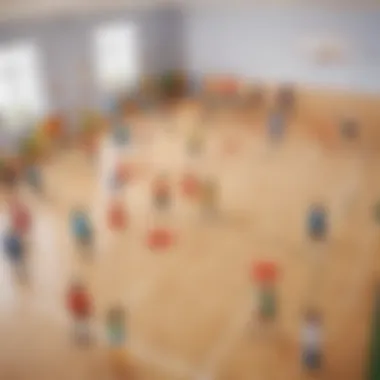
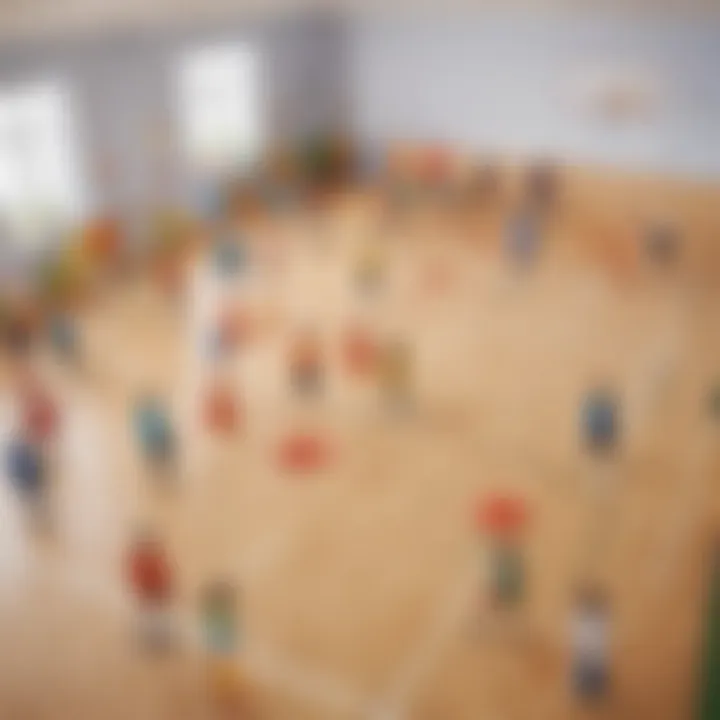
Active Games
Active games are crucial for teaching children the value of physical movement. These games encourage children to engage physically, promoting cardiovascular fitness and coordination.
Tag Games
Tag games are versatile and adaptable, making them an enduring favorite in physical education. The main aspect of tag games is their simplicity; all that is needed is a designated area and a few participants. This simplicity allows for easy implementation in various settings.
Tag games promote agility, speed, and decision-making skills. One key characteristic is their ability to incorporate numerous players at once, enhancing social interaction. The main benefit of tag games is that they require minimal equipment and can be modified to fit different age groups or physical abilities. However, one disadvantage may be the potential for minor injuries if safety measures are not enforced.
Relay Races
Relay races are structured, competitive games that encourage teamwork and communication among participants. Their specific aspect lies in the nature of the race, where teams compete to complete designated tasks in succession. This format fosters a sense of unity as well as healthy competition.
Relay races highlight the importance of strategy and cooperation. A unique feature is the hand-off element, where participants must coordinate smoothly to keep the race going. While relay races promote physical agility and teamwork, they can require more space and equipment, making them slightly less accessible than tag games for some settings.
Cooperative Games
Cooperative games focus on collaboration rather than competition. These games help children learn to communicate, share, and work together towards a common goal.
Group Challenges
Group challenges are designed to strengthen teamwork and problem-solving abilities. A key aspect is that these activities require participants to work together to solve a task or overcome an obstacle. This fosters a sense of belonging and community among kindergarteners.
The benefit of group challenges lies in their emphasis on group dynamics, allowing children to build social skills. They can also be adjusted to suit various age groups and abilities. An advantage is that they often require minimal equipment, making them easy to introduce. One potential downside might be that some children may dominate the activity, which requires guidance from educators to ensure equity.
Team Sports
Team sports introduce children to structured gameplay and the concept of roles within a group setting. They encourage cooperation and strategic thinking while navigating rules and guidelines. The key characteristic is that they involve organized competition, promoting physical fitness and socialization.
Team sports offer a fun way to instill competitive spirit while focusing on collaboration. A unique feature is the regular practice involved, which can help reinforce unity among teammates. However, these sports might require more extensive resources and space, limiting their adaptability for all kindergarten settings.
Creative Movement Activities
Creative movement activities allow children to express themselves through physical activity, focusing on imagination and personal expression.
Dance
Dance encompasses various movements and styles, fostering creativity in physical education. The primary aspect of dance is the emphasis on rhythm and coordination. It aids in developing gross motor skills while allowing for personal expression.
Dance is advantageous as it can be tailored to suit any group size and can be practiced in various environments. Importantly, it also promotes cultural awareness and appreciation. However, some children might feel self-conscious about dancing, potentially limiting their engagement unless normalized by educators.
Imitate Animal Movements
Imitating animal movements is a playful activity where children mimic animals. This unique approach encourages active participation and enhances understanding of body mechanics. It connects physical movement with imaginative play, making it highly engaging.
The key characteristic of this activity is its focus on fun while promoting physical literacy. The playful nature attracts children, fostering interest and excitement. However, care should be taken to ensure all movements are safe to prevent injury, as some might be physically demanding.
Implementing Physical Education Games
Implementing physical education games in kindergarten is crucial for fostering holistic development in young children. As children are naturally inclined to play, incorporating structured physical activities enhances their learning process. It encourages physical engagement, social interaction, and cognitive growth. Furthermore, effectively implemented games boost motivation and create an enjoyable environment that promotes lifelong health habits. The process involves various elements, such as establishing safety measures, planning activities, and providing necessary guidance during gameplay. These factors collectively ensure that the games are not only entertaining but also educational and beneficial.
Creating a Safe Learning Environment
Safety forms the foundation of any physical education program. In a kindergarten setting, children are still developing their awareness of their surroundings. Thus, setting up a safe learning environment is paramount. First, evaluate the play area for hazards. Remove any obstacles that could cause falls or injuries. It is essential to use appropriate equipment that is age-appropriate and in good condition.
A safe space nurtures confidence in children, allowing them to explore and engage actively without fear.
Additionally, establishing rules and boundaries helps manage behavior and ensures that all children understand the importance of safety. Teachers should model safety practices regularly. Encouraging conversations about safety and the importance of playing respectfully can instill lifelong lessons in the young minds.
Planning and Structuring Activities
Effective planning is integral to the success of physical education games. The key is to outline clear objectives for the activities. What skills do you want the children to develop? For example, focus on enhancing motor skills, teamwork or coordination during different games. Divide activities into manageable segments to maintain engagement. Shorter, varied sessions keep the children excited and eager to participate.
When planning, consider the physical space available. Ensure activities are suitable for the environment, whether indoors or outdoors. Additionally, think about the diversity of the children involved, including their skill levels. Tailoring activities to meet various needs ensures inclusivity, allowing every child to participate and learn effectively.
Guiding Players During Games
Guidance is a significant component in facilitating kindergarten physical education games. It is the educator's role to create an atmosphere of encouragement rather than competition. Before starting any game, provide a clear demonstration and explanation of the rules. Children benefit from visual aids or actions that demonstrate the gameplay. Use simple language to communicate key points.
During gameplay, observe the children closely. Offer support, correction, and praise where necessary. This helps them understand their strengths and areas for improvement. Moreover, remind them about safety practices throughout the game. Allow opportunities for reflection after activities. Discussing how they felt, what they learned, and how they can further improve reinforces the lessons taught through play.
Implementing physical education games requires careful attention to detail. The importance of safety, well-structured planning, and effective guidance contributes significantly to a successful physical education experience. These elements lay the groundwork for a fun, enriching, and meaningful learning journey.
Engaging Caregivers and Educators
Engaging caregivers and educators in kindergarten physical education is crucial for fostering an environment that encourages physical activity and play. Active involvement from adults can significantly enhance the learning experience of children. When caregivers understand the purpose and benefits of physical education, they can better support the activities both at school and at home. This collaboration helps to nurture a culture of health and wellness among young learners.
Training and Resources for Educators
Proper training for educators is fundamental to the success of physical education programs. Educators need to be equipped with the tools and knowledge necessary for facilitating engaging and effective physical activities.
- Professional Development: Ongoing professional development workshops can help educators learn about the latest practices in teaching physical education. Topics may include the use of technology in physical education and innovative games that promote various skill sets.
- Curriculum Resources: Access to high-quality curriculum resources is vital. Educators should utilize lesson plans that are tailored to young children. These resources must be adaptable to various skill levels in the classroom.
- Community Support: Partnering with local organizations can also provide additional resources and support. Communities often offer coaches or volunteers who can assist in physical education classes.
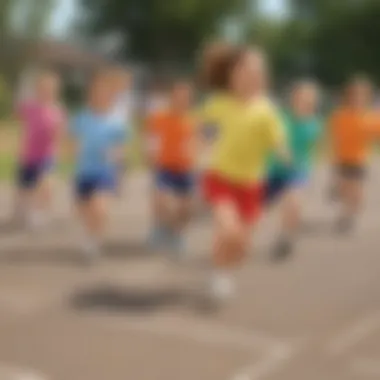
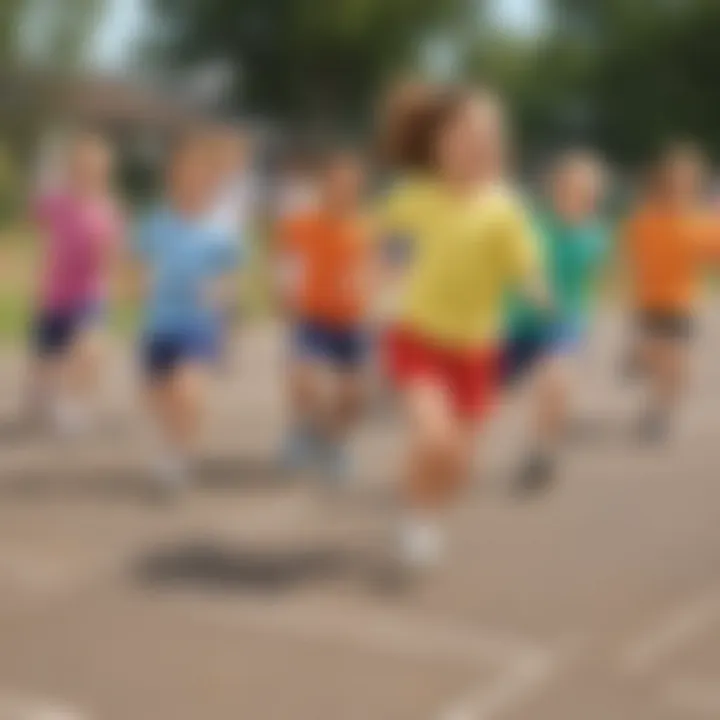
Educators who are well-trained are more confident in their ability to implement successful strategies that promote physical activity.
Involving Parents in Physical Education
Involving parents is another essential element in fostering a supportive environment for kindergarten children. When parents are engaged, children are more likely to participate actively in physical education activities.
- Communication: Establishing clear lines of communication between educators and parents is key. Informational sessions can explain the importance of physical education and how parents can support their children at home.
- Family Events: Organizing family-oriented physical education events can create opportunities for parents to join in on the activities. These events allow parents to see firsthand the benefits of physical education and how it contributes to their child’s development.
- Home Activities: Providing parents with suggestions for home-based physical activities can extend learning beyond the school environment. Engaging children in physical play at home reinforces the skills learned in school.
In summary, engaging both caregivers and educators establishes a cohesive approach to promoting physical education. This collaborative effort amplifies the impact of physical activity on kindergarteners.
"When families and educators work together, children's well-being and success in physical activities are significantly enhanced."
Promoting the active participation of caregivers and educators ultimately leads to a nurturing and enriching environment for young learners.
Assessment and Progress Tracking
Assessment and progress tracking in kindergarten physical education is crucial for understanding children’s development. This process helps educators identify children’s strengths and areas needing improvement. Tracking is not just about grading or scores; it's a holistic approach to gauge growth. When educators monitor skill development, they observe how children perform various activities. They collect data on motor skills, social interactions, and emotional balance during games. This method provides essential insights into the overall effectiveness of physical education programs.
Moreover, evaluating progress allows for adjustments in teaching strategies. If certain games are effective in engaging children, it is wise to incorporate more of those into the curriculum. Likewise, if some games prove challenging for most students, they may need modifications to ensure accessibility and relevance to all participants.
Benefits of quality assessment include:
- Enhanced understanding of individual student needs.
- Development of tailored physical activities.
- Encouragement of a growth mindset among children.
"Effective assessment empowers educators to support every child's unique journey in physical development."
Assessments can also foster communication between educators and parents. By sharing progress reports, parents understand how their children are doing in physical education, leading to more support at home. Thus, tracking progress is not just beneficial for educators; it creates an environment where stakeholders are informed and engaged in the child's physical growth.
Monitoring Skill Development
Monitoring skill development is essential in kindergarten physical education. By observing children during games, educators can see how each child progresses in key areas like coordination, balance, and strength. This can involve assessing gross motor skills, such as running and jumping, and fine motor skills, which might include throwing or catching a ball.
Here are some methods to effectively monitor skill development:
- Observation: Watch children as they participate in games. Noting their movements can provide insight into their abilities and development over time.
- Checklists: Use checklists to track specific skills. A checklist ensures that educators cover all essential areas of development.
- Feedback: Providing constructive feedback during activities helps children understand their progress and what they can improve.
Evaluating Participation and Engagement
Evaluating participation and engagement presents an important aspect of tracking physical education progress. Engagement in activities is not merely about being physically present; it’s about how actively involved children are in the games. High levels of participation usually indicate that children find the activities enjoyable and are willing to learn.
Educators can evaluate participation through the following:
- Observation of Behavior: Look for signs of enthusiasm, such as smiling and eagerness to engage in activities.
- Participation Rates: Take note of how many children are taking part in each game. A game that involves most children may be more engaging than one with low participation.
- Self-Reflection: Encourage children to express how they feel about the games and what they enjoy most.
Tracking these elements helps in creating a vibrant and enjoyable physical education experience. Understanding children’s participation helps adjust activities to increase engagement and learning. If certain games are neglected, it’s an indication that they may need re-evaluation or replacement.
By continually assessing both skill development and engagement levels, educators can ensure a comprehensive approach to physical education that supports the holistic growth of kindergarten students.
Future Trends in Kindergarten Physical Education
The landscape of kindergarten physical education is rapidly evolving. Understanding future trends is key to enhancing learning experiences in physical education. These trends reflect a change in how educators approach physical games and activities, incorporating new methodologies and tools to support child development. As technology advances and educational standards adapt, schools must stay informed about these changes to create enriching environments for young children.
Technology Integration in Physical Games
Technology has a significant role in modern education. In physical education, the integration of technology creates exciting opportunities for engagement and learning. Interactive tools can promote physical activity while offering data-driven insights to educators. For example, using fitness tracking devices can help monitor children's movement patterns and activity levels.
Here are some ways technology can enhance physical education games:
- Digital Coaching: Apps can provide real-time guidance on proper techniques and game strategies.
- Interactive Learning Tools: Tablets and smartboards can be used to demonstrate movements and rules visually, making it easier for young learners to grasp concepts.
- Gamification: Incorporating game mechanics into physical activities can motivate students. Activities can include scorekeeping, achievements, and even competitive elements that capture children's attention.
Despite the benefits, it's crucial to ensure balance and safety when integrating technology. Monitoring screen time and ensuring activities remain physical is vital, as too much reliance on tech could detract from the primary goal of physical activity.
Evolving Educational Standards
As educational expectations change, kindergarten physical education must adapt to meet these new benchmarks. Authorities are increasingly recognizing the need for robust physical education programs that align with both physical development and academic success.
Considerations in evolving educational standards include:
- Holistic Development: Current standards emphasize not just physical growth but also social, emotional, and cognitive aspects of child development. Educators must plan games that foster cooperation, communication, and critical thinking.
- Inclusivity: Standards promote an inclusive environment where every child, regardless of ability, can participate fully. This ensures that all games are adaptable and accessible to every student.
- Assessment Techniques: New methods for gauging success in physical education include both formative and summative assessments. Continuous observation helps educators understand student progress and adapt accordingly.
With attention to these evolving standards, educators can create effective programs that significantly impact children's development.
Future-focused physical education is essential, as it prepares children not only for school but for a healthy, active lifestyle.
Finale
Continuing physical education in kindergarten is crucial for fostering foundational skills. Such programs offer structured opportunities for young children to develop physically, mentally, and socially. The importance of ongoing engagement in physical activities cannot be overstated. When children participate in regular physical education, they gain essential motor skills that serve as the building blocks for future athletic ability and coordination. Moreover, these activities instill values such as teamwork and cooperation. Children learn how to interact with peers, navigate conflicts, and celebrate successes together.
The Importance of Continuing Physical Education
Physical education should not be viewed as a standalone activity. It is essential for developing a well-rounded curriculum that includes cognitive and social elements. Keeping young learners engaged in physical activity promotes not only physical health but also mental well-being. Regular exercise has been shown to improve concentration and cognitive function. It helps young minds focus better during learning periods outside of physical activities.
Additionally, continuing physical education lays a foundation for lifelong health. When children engage in fun and varied games, they are more likely to cultivate a positive relationship with physical activity. As they grow, these experiences can translate into regular exercise habits that promote long-term health benefits.
"Physical activity encourages healthy growth and development in children."
Moreover, educators and parents should consider physical education as part of the holistic development of children. A curriculum that emphasizes play-based learning can significantly contribute to child development. This includes learning through creative movement activities, which enhance children's capacity to explore and engage with their environment.
In sum, continuing physical education in kindergarten is vitally important. It equips young children with necessary skills, encourages social interaction, and promotes overall health. Embracing this aspect of early childhood education sets the stage for happy, healthy, and active learners in the future.







